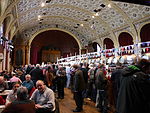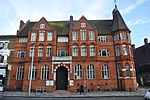The Ascension, Lavender Hill

The Ascension of The Lord, Lavender Hill, is an Anglican church in the Anglo-Catholic tradition, situated on Lavender Hill, in Battersea, South West London. It is thought to be the first church in England dedicated to The Ascension of The Lord. Built to the designs of the architect James Brooks, its foundation stone was laid in 1874, and it was consecrated in 1883. The church is one of three in the parish of Lavender Hill, The Ascension and Battersea, St. Philip with St. Bartholomew. The other two are no longer used by the Church of England. St Philip the Apostle, Queenstown Road is now home to the Ethiopian Orthodox Parish of Saint Mary of Debre Tsion, and St Bartholomew the Less, Wycliffe Road is now home to the Greek Orthodox Parish of St Nectarious.
Excerpt from the Wikipedia article The Ascension, Lavender Hill (License: CC BY-SA 3.0, Authors, Images).The Ascension, Lavender Hill
Lavender Hill, London Clapham Junction (London Borough of Wandsworth)
Geographical coordinates (GPS) Address External links Nearby Places Show on map
Geographical coordinates (GPS)
| Latitude | Longitude |
|---|---|
| N 51.4655 ° | E -0.1574 ° |
Address
The Ascension of Our Lord
Lavender Hill
SW11 5QN London, Clapham Junction (London Borough of Wandsworth)
England, United Kingdom
Open on Google Maps











